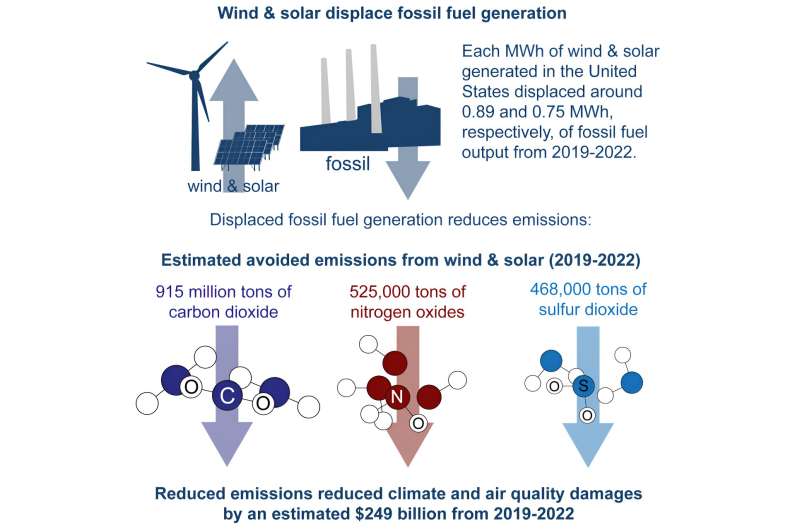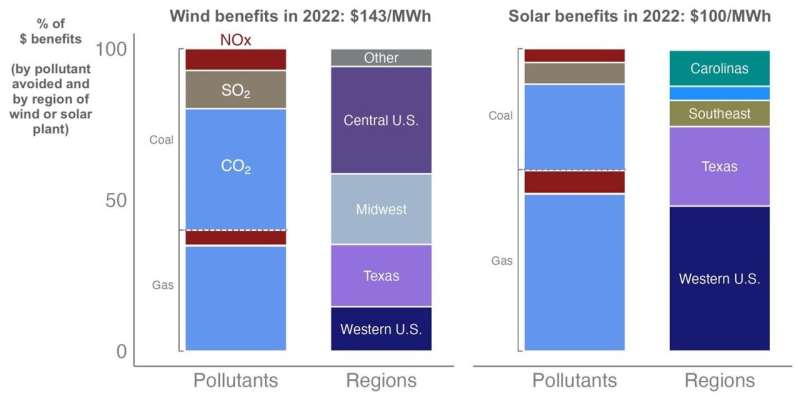This article has been reviewed according to Science X's editorial process and policies. Editors have highlighted the following attributes while ensuring the content's credibility:
fact-checked
trusted source
proofread
US wind and solar generation provided $249 billion in climate and air quality health benefits from 2019–2022: Study

A new study published in the journal Cell Reports Sustainability focuses on the air quality and climate benefits of wind and solar energy.
Though past studies have demonstrated that wind and solar generation provide substantial health and climate benefits, this research provides an important update: It accounts for recent changes in the electricity system (including the continued growth of wind and solar to provide over 30% of total generation in some regions), it includes recent updates to health impact and climate impact research, provides a new quantitative analysis of uncertainty, and it uses an approach that facilitates annual updates and replication in new regions. The article is free and publicly available.
The study evaluates the benefits of wind and solar generation through reducing sulfur dioxide (SO2), nitrogen oxides (NOx), and carbon dioxide (CO2) emissions. The study estimates the dollar value of emission reductions and the number of avoided premature mortalities.
Key findings
- In 2022, wind and solar generation provided an estimated total climate and health benefit of 14.3 ¢/kWh-of-wind and 10.0 ¢/kWh-of-solar (or in per MWh units: $143/MWh-of-wind and $100/MWh-of-solar).
- Including only domestic air quality health benefits, the benefits were 3.6¢/kWh-of-wind ($36/MWh-of-wind) and 1.7¢/kWh-of-solar ($17/MWh-of-solar), with the remainder being climate benefits.
- In 2022, wind and solar generation helped reduce enough SO2 and NOx emissions to prevent 1,200 to 1,600 premature mortalities in the United States (reflecting a 5th to 95th percentile uncertainty range).
- Total wind and solar climate and health benefits from 2019—2022 summed to $249 billion.
Wind and solar power provide air quality and climate benefits by reducing the need to generate electricity with fossil fuels such as natural gas and coal. The study uses a statistical model to determine the reduction of natural gas and coal generation that occurred due to wind and solar generation.
The emissions characteristics of these generators were used to determine the likely quantity of avoided emissions. A suite of air quality models was then used to estimate the dollar value of the domestic public health benefits of the avoided SO2 and NOx emissions and an estimate of the social cost of carbon (the global cost of emitting carbon dioxide) was used to find the dollar value of the climate benefits.
The study developed regional estimates of benefits and shows how differences in the location of wind and solar plants leads to differences in benefits. Some of these differences can be observed in the figure below, with wind deriving a majority of its value from the central U.S., the Midwest, and Texas, versus solar which was more concentrated in the Western U.S. and Texas regions.

Both technologies reduce emissions from both natural gas and coal plants, but benefits from wind are more weighted toward emission reductions from coal plants than are benefits from solar. An innovative aspect of the research was to carefully track uncertainty through the use of a Monte Carlo analysis. The resulting uncertainty bounds and discussion of the key drivers of uncertainty are detailed in the full article.
The article includes additional discussion of topics such as interregional trade of wind and solar generation, the additional benefits of reducing methane emissions associated with natural gas production, life-cycle emissions from the manufacture and construction of wind and solar plants, how the addition of battery storage might affect emission benefit calculations, and how the varying operational characteristics of natural gas and coal plants affect benefit estimates ('intermittency effects').
The approach developed in this article relies on relatively simple input data, allowing for annual updates and potentially paving the way for its application to other regions.
More information: Dev Millstein et al, Climate and air quality benefits of wind and solar generation in the United States from 2019 to 2022, Cell Reports Sustainability (2024). DOI: 10.1016/j.crsus.2024.100105

















